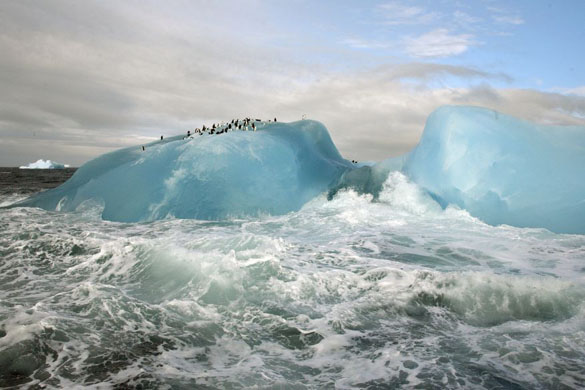Sandy: Berger

The following is from an Ian Frazier article called "Terminal Ice," which was originally published in the October 2002 issue of Outside magazine. The article can be read in its entirety here. "Terminal Ice" is in The Best American Science and Nature Writing 2003, which I got for Christmas. (Thanks, Santa!)
Icebergs are pieces of freshwater ice of a certain size floating in the ocean or (rarely) a lake. They come from glaciers and other ice masses. Because of the physics of ice when it piles up on land, it spreads and flows, and as it does its advancing edge often meets a body of water. When the ice continues to flow out over the water, chunks of it break off in a process called calving. Some of the faster-moving glaciers in Greenland calve an average of two or three times a day during the warmer months. Icebergs are not the same as sea ice. Sea ice is frozen saltwater, and when natural forces break it into pieces, the larger ones are called not icebergs but ice floes. Icebergs are denser and harder than sea ice. When icebergs are driven by wind or current, sea ice parts before them them like turkey before an electric carving knife. In former times, sailing ships that got stuck in sea ice sometimes used to tie themselves to an iceberg and let it pull them through.
A piece of floating freshwater ice must be at least 50 feet long to qualify as an iceberg, according to authorities on the subject. If it's smaller -- say, about the size of a grand piano -- it's called a growler. If it's about the size of a cottage, it's a bergy bit. Crushed-up pieces of ice that result when parts of melting icebergs disintegrate and come falling down are called "slob ice" by mariners. Students of icebergs have divided them by shape into six categories: blocky, wedge, tabular, dome, pinnacle, and dry-dock. The last of these refers to icebergs with columnar sections flanking a water-level area in the middle, like high-rise apartment buildings around a swimming pool.
At the edges of Antarctica, where plains of ice spread across the ocean and float on it before breaking off, most of the icebergs are tabular -- flat on top, horizontal in configuration. In the Northern Hemisphere, because of the thickness of glacial ice and the way it calves, most icebergs are of the more dramatically shaped kinds. Tabular icebergs tend to be stable in the water, and scientists sometimes land in helicopters on the bigger ones to study them. Northern Hemisphere icebergs, with their smaller size and gothic, irregular shapes, often grow frozen seawater on the bottom, lose above-water ice structure to melting, and suddenly capsize and roll. Venturing onto such icebergs is a terrible idea.
Antarctica has about 90 percent of all the ice in the world; most of the rest of it is in Greenland. Those two places produce most of the world's icebergs -- about 100,000 a year from the first, about 10,000 to 15,000 from the other. Glaciers in Norway, Russia, and Alaska produce icebergs, too. The Exxon Valdez went aground in Alaska's Prince William Sound partly because it had changed course to avoid icebergs. Scientists have not been observing icebergs long enough to say if there are substantially more of them today. They know that the total mass of ice in Greenland has decreased at an accelerated rate in recent years. In Antarctica, because of its size and other factors, scientists still don't know whether the continent as a whole is losing ice or not.

<< Home